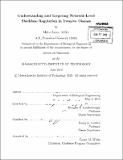Understanding and targeting network-level sheddase regulation in invasive disease
Author(s)
Miller, Miles Aaron
DownloadFull printable version (26.37Mb)
Other Contributors
Massachusetts Institute of Technology. Department of Biological Engineering.
Advisor
Douglas A. Lauffenburger and Linda G. Griffith.
Terms of use
Metadata
Show full item recordAbstract
Regulated cell-surface proteolysis underpins key processes of cellular growth and motility in both physiological and pathological contexts. However, comprehending how multiple proteolytic events cohesively integrate to yield context-dependent cellular behavior remains a challenge in the fields of both protease biology and systems biology in general. This work begins to address that challenge by quantitatively investigating the integrated effect of multiple diverse proteolytic events and their interaction with cell-signaling pathways from a computational network perspective, particularly focusing on A Disintegrin and Metalloproteinases (ADAMs). ADAMs have been studied for decades as the principal cell-surface "sheddases" responsible for cleaving growth factor ligands and receptor tyrosine kinase ectodomains from the cell surface. However, activity regulation, feedback, and catalytic promiscuity impede our understanding of context-dependent sheddase function, and clinical trials targeting metalloproteinases in cancer have failed in part due to a poor understanding of the complex functions they mediate. This thesis outlines a conceptual framework for studying protease network biology (Chapter 1), describes novel experimental methods designed for such a framework (Chapters 2-3), and applies both to understand protease regulation in invasive disease (Chapter 4). Using combined measurement and computational modeling, we present a paradigm for monitoring and analyzing complex networks of protease activities that interface with signaling pathways to influence cellular migration in the invasive diseases of cancer and endometriosis. We find sheddase activity integrates with signaling pathways to direct cell migration, especially through concomitant proteolysis of both ligands and receptors. We find that indirect reduction of sheddase activity through kinase inhibition can lead to an accumulation of growth-factor receptors on the cell surface, consequently producing undesired compensatory signaling feedback. Thus, here we present a novel mechanism of rapid, protease-driven resistance to kinase inhibitors, and we subsequently demonstrate strategies for overcoming resistance through drug combinations. We develop a novel microfluidic platform to study protease activities in clinical samples, and apply the technology to study the peritoneal fluid from endometriosis patients. Results indicate joint dysregulation of sheddase activity with disease. Overall, this work provides a model for measuring, understanding, and targeting networks of proteases and the kinases with which they interact.
Description
Thesis (Ph. D.)--Massachusetts Institute of Technology, Dept. of Biological Engineering, 2013. Cataloged from PDF version of thesis. Includes bibliographical references (p. 197-212).
Date issued
2013Department
Massachusetts Institute of Technology. Department of Biological EngineeringPublisher
Massachusetts Institute of Technology
Keywords
Biological Engineering.